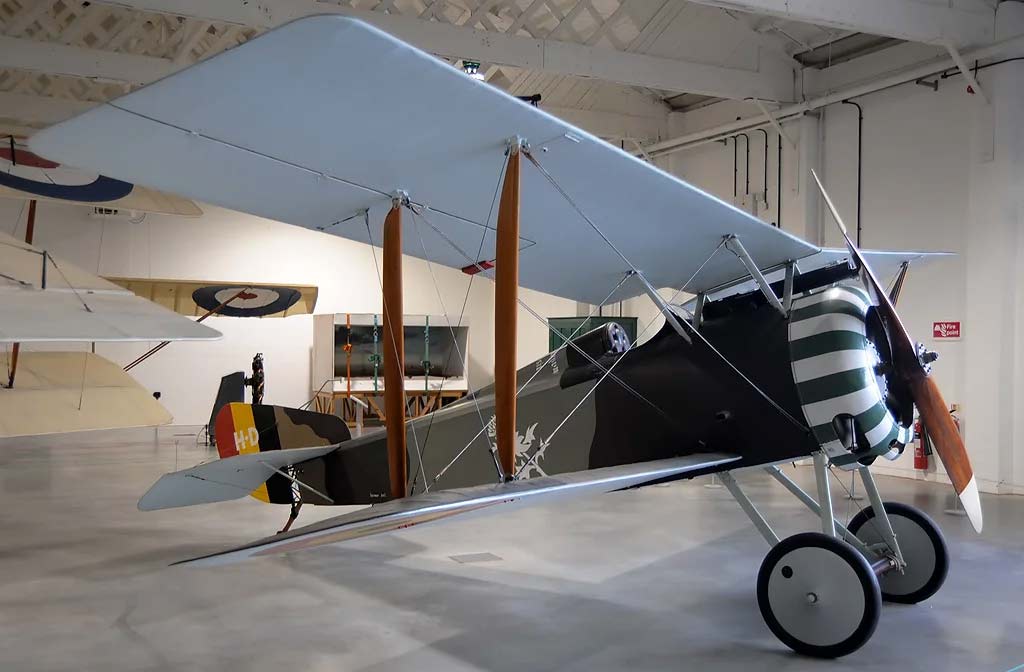Hanriot HD.1: Nimble WWI French fighter with a Le Rhône rotary engine, known for its agility and favored by Belgian and Italian aces. This article delves into the Hanriot HD.1, a World War I French fighter aircraft acclaimed for its maneuverability and effectiveness in combat. It explores the context of its development, the design philosophy behind its construction, its operational performance, and its role in various military engagements. Despite its less famous status, the Hanriot HD.1 made a substantial impact on the air war of its time and was utilized by several countries, illustrating its adaptability and combat prowess.
The Hanriot HD.1 was a French single-seat fighter aircraft that emerged during the later stages of World War I. It became a valuable asset for the air forces that employed it, particularly the Belgian and Italian aviators, who capitalized on its combat capabilities.
History of the Development of the Hanriot HD.1
The development of the Hanriot HD.1 occurred during a pivotal moment in World War I when the importance of air superiority became unequivocally clear. The Allies needed aircraft that could match and surpass the German fighters’ prowess, leading to a surge in the development of more agile and effective fighter planes.
The Hanriot company, led by René Hanriot, initiated the HD.1 project to create a lightweight, highly maneuverable fighter that could engage enemy aircraft with agility and precision. The program was launched in the midst of WWI’s most intense aerial combat phase, with the goal of providing a counter to the increasingly effective German fighters.
First flying in 1916, the HD.1 was designed as a straightforward, compact fighter with excellent flight characteristics. It was not ordered by the French air force, who had already chosen the SPAD S.VII as their primary fighter. As a result, the HD.1 found a role in the Belgian and Italian air services, where it was highly regarded.
Design of the Hanriot HD.1
The Hanriot HD.1’s design focused on simplicity and maneuverability. It was a conventional biplane with a wingspan of 8.5 meters (27 feet 10 inches) and a length of 5.85 meters (19 feet 2 inches). The airframe was primarily constructed of wood with fabric covering, which was typical for the era.
It featured ailerons on both the upper and lower wings, contributing to its agility, and a distinctive semi-circular tailfin. The HD.1’s undercarriage was fixed and robust, designed to handle the rough fields serving as makeshift airfields during the war.
Powered by a 110 hp Le Rhône 9J rotary engine, the HD.1 was not the fastest fighter of its time, but it excelled in climb rate and maneuverability. The circular cowling and side cutouts provided adequate cooling for the rotary engine, which was essential for the engine’s performance and reliability.
A notable design feature was its open cockpit, which provided the pilot with excellent visibility, a critical factor in the dogfights of WWI. The aircraft’s lightweight construction meant that it was more nimble than many of its contemporaries, though it also made it somewhat fragile compared to more heavily built aircraft.

Performance of the Hanriot HD.1
The HD.1’s Le Rhône engine enabled a top speed of approximately 185 km/h (115 mph), with a service ceiling of around 6,500 meters (21,325 feet). Its operational range was about 300 kilometers (186 miles), sufficient for the short-range sorties typical of the era’s combat.
When compared to its contemporaries like the Albatros D.III and the later Fokker D.VII, the HD.1 lacked in speed but outperformed many in maneuverability and rate of climb. It was not the most powerful, but its agility made it a formidable adversary in a dogfight.
Military Use and Combat of the Hanriot HD.1
The armament of the HD.1 typically consisted of one or two synchronized Vickers or Lewis machine guns, providing it with adequate firepower for its time. The machine guns were mounted above the engine, firing through the propeller arc, a standard configuration for single-seat fighters of the period.
While initially not adopted by the French, the HD.1 saw considerable use with the Belgian and Italian forces. It was a favorite among many ace pilots, who used its superior maneuverability to great effect against German aircraft. The HD.1 served with distinction on the Italian front, where its capability to operate at higher altitudes was a significant advantage.
Post-war, the HD.1 was sold to several countries, including Switzerland and the United States, for use in various roles, from training to postal service. By the early 1920s, the rapid advancement in aviation technology rendered the HD.1 obsolete, leading to its replacement by newer, more capable aircraft.
The Hanriot HD.1 represents a fascinating chapter in WWI aviation history, underlining the importance of agility and pilot skill in early aerial combat. While not as renowned as some of its peers, the HD.1’s influence and the affection with which it was regarded by those who flew it speak volumes about its contribution to the first air war. Its story is a testament to the ingenuity and rapid evolution of aircraft design during a period of intense technological advancement.
Back to the Warbirds section.